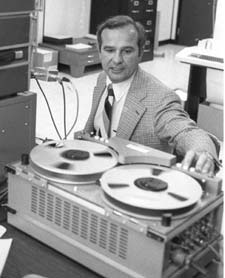Thomas G. Stockham: Difference between revisions
No edit summary |
No edit summary |
||
| (4 intermediate revisions by the same user not shown) | |||
| Line 1: | Line 1: | ||
{{Biography | |||
|Image=Stockham.jpg | |||
|Caption=Thomas G. Stockham, a pioneer researcher in digital audio recording. Courtesy: Special Collections Dept., J. Willard Marriott Library, University of Utah | |||
|Birthdate=1933/12/22 | |||
|Associated organizations=University of Utah; MIT | |||
|Fields of study=Signal processing | |||
|Awards=[[IEEE Jack S. Kilby Signal Processing Medal]] | |||
}} | |||
Thomas G. Stockham, Jr., is often called the father of digital recording in honor of his pioneering work in the fields of digital recording and tapeless editing. | Thomas G. Stockham, Jr., is often called the father of digital recording in honor of his pioneering work in the fields of digital recording and tapeless editing. | ||
| Line 13: | Line 15: | ||
A highlight of Stockham’s career was a 1975 paper published in an IEEE journal, which was called “Blind Deconvolution Through Digital Signal Processing.” In this article, Stockham discussed his work restoring (through digital techniques) old [[Phonograph|phonograph]] recordings of famous Italian opera singer, Enrico Caruso. | A highlight of Stockham’s career was a 1975 paper published in an IEEE journal, which was called “Blind Deconvolution Through Digital Signal Processing.” In this article, Stockham discussed his work restoring (through digital techniques) old [[Phonograph|phonograph]] recordings of famous Italian opera singer, Enrico Caruso. | ||
During his professional career Stockham received a number of prestigious awards, including an Emmy and Grammy, for his contributions to audio technology. | During his professional career Stockham received a number of prestigious awards, including an Emmy and Grammy, for his contributions to audio technology. | ||
[[Category:People and organizations]] | |||
[[Category:Engineers]] | |||
[[Category:Inventors]] | |||
[[Category:Signals]] | |||
[[Category:Signal processing]] | |||
[[Category:Digital signal processing]] | |||
[[Category:Signal generation & recording]] | |||
[[Category:Audio recording]] | |||
[[Category:Digital recording]] | |||
{{DEFAULTSORT:Stockham}} | |||
Latest revision as of 15:09, 1 February 2019
- Birthdate
- 1933/12/22
- Associated organizations
- University of Utah, MIT
- Fields of study
- Signal processing
- Awards
- IEEE Jack S. Kilby Signal Processing Medal
Biography
Thomas G. Stockham, Jr., is often called the father of digital recording in honor of his pioneering work in the fields of digital recording and tapeless editing.
Born in 1933, Stockham earned a doctorate from the Massachusetts Institute of Technology (MIT). After completing his academic work in 1959, Stockham was employed as Assistant Professor of electrical engineering at his alma mater. In 1968 he moved to Utah where he became a professor of electrical engineering at the University of Utah.
In the late 1960s Stockham began experimenting with digital tape recording and in 1975 he and business partner Malcolm Low founded Soundstream Incorporated in Salt Lake City. Soundstream was the first commercial digital recording company in the United States. From 1975 to about 1980 Soundstream developed new digital audio recording technologies for professional use. Stockham and a team of engineers and technicians began perfecting the art of making digital master recordings with a computerized editing system and pioneered tapeless hard disk editing. In 1980 Soundstream merged with Digital Recording Company and became DRC/Soundstream.
A highlight of Stockham’s career was a 1975 paper published in an IEEE journal, which was called “Blind Deconvolution Through Digital Signal Processing.” In this article, Stockham discussed his work restoring (through digital techniques) old phonograph recordings of famous Italian opera singer, Enrico Caruso.
During his professional career Stockham received a number of prestigious awards, including an Emmy and Grammy, for his contributions to audio technology.
